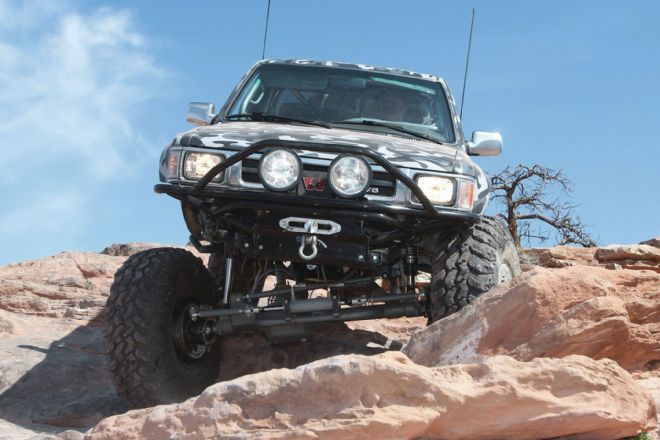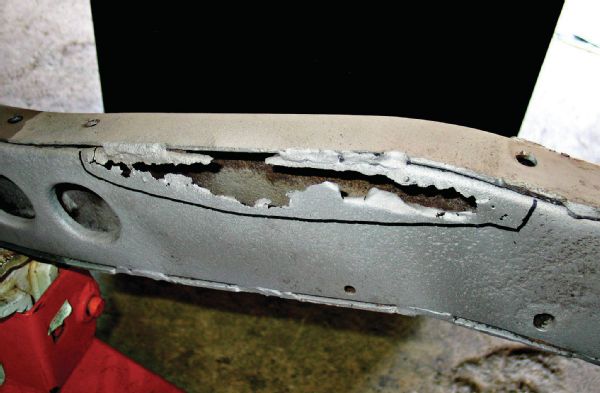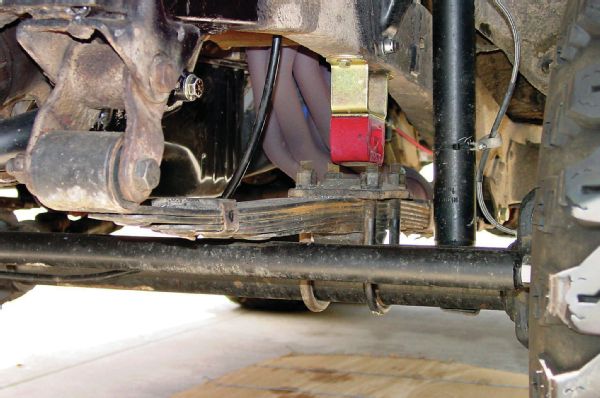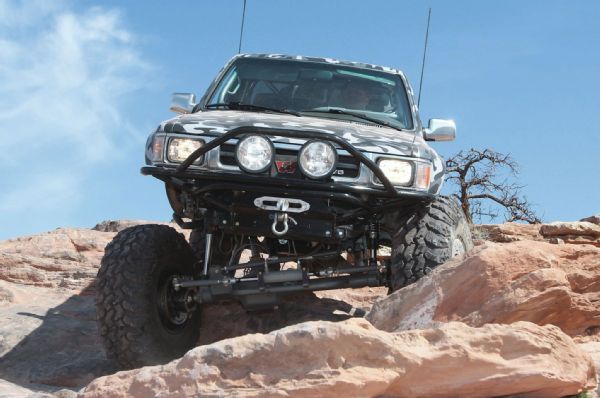
 John Cappa
Former Editor, Four Wheeler
John Cappa
Former Editor, Four Wheeler
Frame Repair 101
Q I need help using a Longevity MIG welder. Does anyone have any experience in repairing a frame?
D-man7
Via fourwheeler.com

A For obvious safety reasons, repairing a frame is something that should only be performed by an experienced welder/fabricator. If the frame is bent from an accident, you will need to have a body shop put the vehicle on a frame straightener. Rust-infested frames will need to be thoroughly inspected and repaired by someone who knows what they are looking at. Repairing a frame isn’t really a good first-time welding project because of the safety concerns. We’d suggest tackling some less structural welding and fabrication projects to gain experience before laying beads on your frame.
Spring-Over Difficulty?
Q I would like to do a spring-over conversion on my 1969 CJ-6. I have an offset Dana 44 in the rear and a Dana 30 with 11-inch disc brakes in front. What should the pinion angles be? Do I need to relocate any steering parts? I plan to use the crossover steering system that came on the Dana 30. On a scale from 1 to 10, how hard will this conversion be?
Scotty T
Via fourwheeler.com

A On a scale of 1 to 10, 1 being changing your oil, and 10 being building a tube chassis, performing a properly functioning spring-over on a Jeep like your CJ-6 is about a 6 or 7. To perform a poorly functioning spring-over would be about a 3. Technically speaking, it’s not all that hard to put the springs on top of the axles. All it requires is moving the spring perches. The difficulty comes in the form of making the steering, brake lines, and driveshafts work, as well as getting a handle on axlewrap.
You will need longer driveshafts, and your pinion angles will depend on several factors. If you have a CV driveshaft in the rear, the rear pinion should be nearly in line with the rear driveshaft, minus a degree or two to compensate for normal leaf-spring wrap under load. If it’s a standard single U-jointed driveshaft in the back, the angles of the T-case yokes and axle yokes should be nearly equal to cancel out any vibration. Again, the axle-end U-joint should be 1-2 degrees less than the angle of the T-case end of the driveshaft. You’ll need to cycle the suspension to check for binding at the U-joints. Any binding at all will eventually lead to driveshaft failure. You can get increased angularity from the driveshafts by upgrading to different U-joints and yokes. Tom Wood’s Custom Driveshafts (customdriveshafts.com) specializes in long-slip driveshafts and high-angle yokes and U-joints that will work well for your application.
Up front, the pinion angle should be similar to stock after performing the spring-over. Altering the front pinion angle will change the caster built into the steering. You generally don’t want to do that because it will have adverse effects on the handling of your Jeep. Small pinion angle/caster changes to make the front driveshaft not bind are acceptable, but you don’t want to go more than one or two degrees positive or negative from the factory setting. It’s usually a delicate balance when getting the steering, front driveshaft, and caster to all work together on a spring-over conversion.
The crossover steering components will be extremely helpful in making your conversion a success. However, you will likely need a longer drag link than the one currently on your Jeep.
Ultimately, many people incorrectly believe that a spring-over is a cheap and easy way to get a lot of lift and suspension flex. The truth is that a properly done spring-over will generally cost more than double the price of a bolt-on lift kit. Consider your options and understand the drawbacks of a spring-over before you cut up your Jeep.
TTB Max Tire Size
Q What is the largest diameter tire I should run on an ‘86 Ford F-150 Dana 44 TTB? I want to run 40-inch tires with 5.89 gears. Can it be done?
Bigg-redd
Via fourwheeler.com
A It can always be done, but should it is a better question. Overall, the TTB Dana 44 front axle is about the same strength as a standard solid-axle high-pinion Dana 44. However, the shafts are a bit weaker. Those 40-inch tires are generally too much for the TTB Dana 44, or any Dana 44 for that matter. The max tire size we would recommend for the mid-sized Dana axle is a 35- to 37-inch, especially if you use it off-road. Street machines could get away with this combo nearly indefinitely, but 40-inch tires and aggressive off-road use will take its toll on the Dana 44 gears, U-joints, and axleshafts. Add a locker to the front and the expected lifespan will be even shorter. However, it is possible to keep this combo alive if you drive sanely. Tire spinning, jumping your 4x4, and throttle bouncing up climbs are this combo’s killers, though. It’s a combo that’s asking for trouble so make sure you carry spare parts when you wander off the beaten path.
Jeep Rot
Q I have a 1999 Jeep Wrangler that is currently experiencing frame rot. Would Chrysler do anything for me in this matter, or am I on my own on this one? Currently, the vehicle only has 140,000 miles on the original 4.0L, but the body is in great shape, and everything else is mechanically sound. I don’t have much money to spend on a potentially expensive repair, so I’m really looking for suggestions here. Any help would be greatly appreciated!
Kris Rickson
Via facebook.com/fourwheelermag
A Unfortunately, your Jeep is well outside of the corrosion warranty period. It can be repaired though. Auto Rust Technicians (autorust.com) specializes in this kind of frame repair. The company offers its Safe-T-Cap frame reinforcement plates, too. The Safe-T-Cap plates are welded to the frame once the rusty sections are removed. Another, more costly and time-consuming option is to replace the entire frame with a good rust-free used one from a company like Collins Bros. Jeep (collinsbrosjeep.com).
Hub Poppin’ Driver
Q I have a Jeep J-truck on 38-inch tires. I’m running a Dana 44 with an OX Locker out of an early 80’s ¾-ton Chevy. I’m having trouble keeping the locking hubs alive. Any ideas on durable locking hubs? I’ve gone through two sets of Warn Premium hubs in the last four months.
Name Withheld
Via email
A The Warn Premium hubs (warn.com) are about the best you can get. Superwinch (superwinch.com) offers some great locking hubs too. The problem lies in that you are running the ragged edge of what a Dana 44 can handle. The 38-inch tires, fullsize-ish truck, and V-8 engine put a lot of stress on the mid-sized axle. You could switch to a set of full-time drive slugs from an FSJ Wagoneer. That would be as strong as you can get, but the frontend will always be spinning and it will likely cause a weak point to surface somewhere else in the axle assembly.
If used strategically, the selectable locker up front is a big help when trying to keep a Dana 44 axle alive in an application like yours. Most of the time you don’t need the locker engaged. Leaving the frontend unlocked in tight corners and on regular trail rides will eliminate a lot of unnecessary axleshaft, U-joint, and locking hub stress.
IFS Assist
QI really enjoyed your articles on steering cures in the March 2014 issue. Will you be doing an article on independent suspension versus solid axle? I know there’s disadvantages and advantages to both, but it’d be nice to see an article with a professional’s opinion. Also, is there such thing as steering assist, stabilizers, and rams for independent suspension?
Thomas Rikala
Via email

A Interestingly enough, we did exactly that story in the August 2013 issue (“Frontend Feud”). You can read the story online here: http://bit.ly/1mqwFM1. The Four Wheeler staff took a stand on which suspension setup was best. The end result was that it really depends on how you plan to use the 4x4 and the kind of performance and durability you expect from it. The Four Wheeler staff took a stand on which suspension setup was best. The end result was that it really depends on how you plan to use the 4x4 and the kind of performance and durability you expect from it.
Steering assists and stabilizers do exist for IFS suspensions. Nearly every aftermarket suspension manufacturer offers steering stabilizer kits for many IFS 4x4s. However, most new IFS 4x4s have what is known as a rack-and-pinion steering assembly. Due to their design, there is far less you can do to modify them, aside from scrapping the whole system and building something custom from scratch. Companies such as Howe Performance Power Steering (howeperformance.com) offer complete high-performance ram-assist rack-and-pinion systems which are used in desert racing. They are extremely durable, powerful, and expensive." Steering assists and stabilizers do exist for IFS suspensions. Nearly every aftermarket suspension manufacturer offers steering stabilizer kits for many IFS 4x4s. However, most new IFS 4x4s have what is known as a rack-and-pinion steering assembly. Due to their design, there is far less you can do to modify them, aside from scrapping the whole system and building something custom from scratch. Companies such as Howe Performance Power Steering (howeperformance.com) offer complete high-performance ram-assist rack-and-pinion systems which are used in desert racing. They are extremely durable, powerful, and expensive.
IFS 4x4s with a standard steering box typically have an idler arm and center link that can be modified to accept a ram assist. The problem lies in that the tie-rod ends of these 4x4s are not up for the task of turning larger than stock tires via a ram assist. In most cases, you’ll need to upgrade the idler arm, center link, and tie rods to successfully perform a modification like this.
Axle Value Menu
Q I can easily see the benefits of having a lighter axle (“Jeep Axle Wrangling”, April 2014), but the reasons behind getting a new axle versus a junkyard axle are not so obvious. In all the talk about weight, spline count, width, ring-gear size, and how much weight each would support, you left out the part of the conversation every off-roader talks about, regardless of what part is being discussed -- the cost! Just deciding a new axle is the right choice, versus getting a junkyard axle (and giving it new shafts, ring-and-pinion, and locker), is not so obvious for those of us who are concerned about saving a few bucks. How about giving us the info about how much each option costs so we can better follow your decision process?
Alfred
Via email
A It isn’t as easy as you might think to come up with an across-the-board cost of building a junkyard axle in unknown condition. We have rolled out of our local wrecking yard with axles that were complete and ready to run as is, and we have also found axles that were so used up that only the diff cover was worth saving. Gearing, locker, and lug pattern selection have a tendency of altering the overall cost immensely. Simply changing your junkyard axle from an eight-lug to a common five-lug could make the axle 10 or more times expensive than the initial purchase price. Higher quality gears and axleshafts cost more than less expensive and weaker imported units. Even some axle ratios are more expensive than others. Selectable lockers can cost at least twice as much as a non-selectable locker. Ultimately, there is no possible way to price every possible scenario; that’s why we broke the axles down by a general build budget rather than an actual dollar figure.
Where To Write
Have a 4x4 tech question you want answered in Techline, drop an email to fourwheelereditor@sorc.com or head on over to our forums at fourwheeler.com. All letters become the property of Four Wheeler, and we reserve the right to edit them for length, accuracy, and clarity. Due to the volume of mail, electronic and otherwise, we cannot respond to every reader, but we do read everything.